Applied Business Finance: A Detailed Report on Financial Management
VerifiedAdded on 2023/06/14
|16
|2976
|406
Report
AI Summary
This report provides a comprehensive overview of financial management within a business context. It begins by defining financial management and its importance, emphasizing key decisions like financing, investing, and dividend policies. The report then delves into the main financial statements, including the income statement, balance sheet, and statement of cash flows, explaining their purpose and utility in evaluating a company's financial health. Ratio analysis is discussed as a critical tool for assessing liquidity, leverage, turnover, and profitability. A business review template, along with sample income statement and balance sheet data, is presented. The report concludes with specific recommendations for improving business performance, focusing on professional expertise, financial tools, and cost reduction strategies, based on an analysis of the provided financial data. Desklib offers a platform for students to access this and other solved assignments to aid in their studies.

Applied Business
Finance
Finance
Paraphrase This Document
Need a fresh take? Get an instant paraphrase of this document with our AI Paraphraser
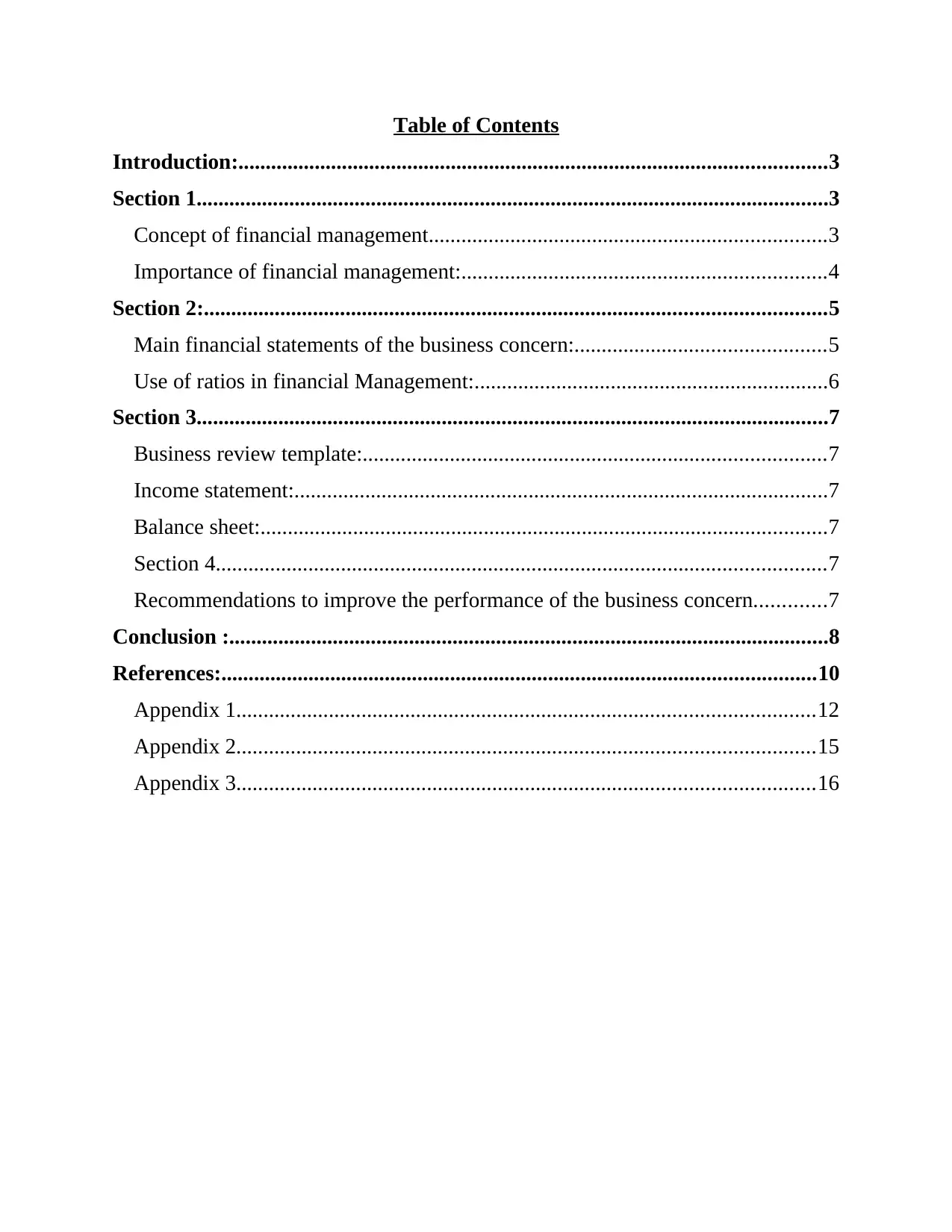
Table of Contents
Introduction:............................................................................................................3
Section 1....................................................................................................................3
Concept of financial management.........................................................................3
Importance of financial management:...................................................................4
Section 2:..................................................................................................................5
Main financial statements of the business concern:..............................................5
Use of ratios in financial Management:.................................................................6
Section 3....................................................................................................................7
Business review template:.....................................................................................7
Income statement:..................................................................................................7
Balance sheet:........................................................................................................7
Section 4................................................................................................................7
Recommendations to improve the performance of the business concern.............7
Conclusion :..............................................................................................................8
References:.............................................................................................................10
Appendix 1..........................................................................................................12
Appendix 2..........................................................................................................15
Appendix 3..........................................................................................................16
Introduction:............................................................................................................3
Section 1....................................................................................................................3
Concept of financial management.........................................................................3
Importance of financial management:...................................................................4
Section 2:..................................................................................................................5
Main financial statements of the business concern:..............................................5
Use of ratios in financial Management:.................................................................6
Section 3....................................................................................................................7
Business review template:.....................................................................................7
Income statement:..................................................................................................7
Balance sheet:........................................................................................................7
Section 4................................................................................................................7
Recommendations to improve the performance of the business concern.............7
Conclusion :..............................................................................................................8
References:.............................................................................................................10
Appendix 1..........................................................................................................12
Appendix 2..........................................................................................................15
Appendix 3..........................................................................................................16
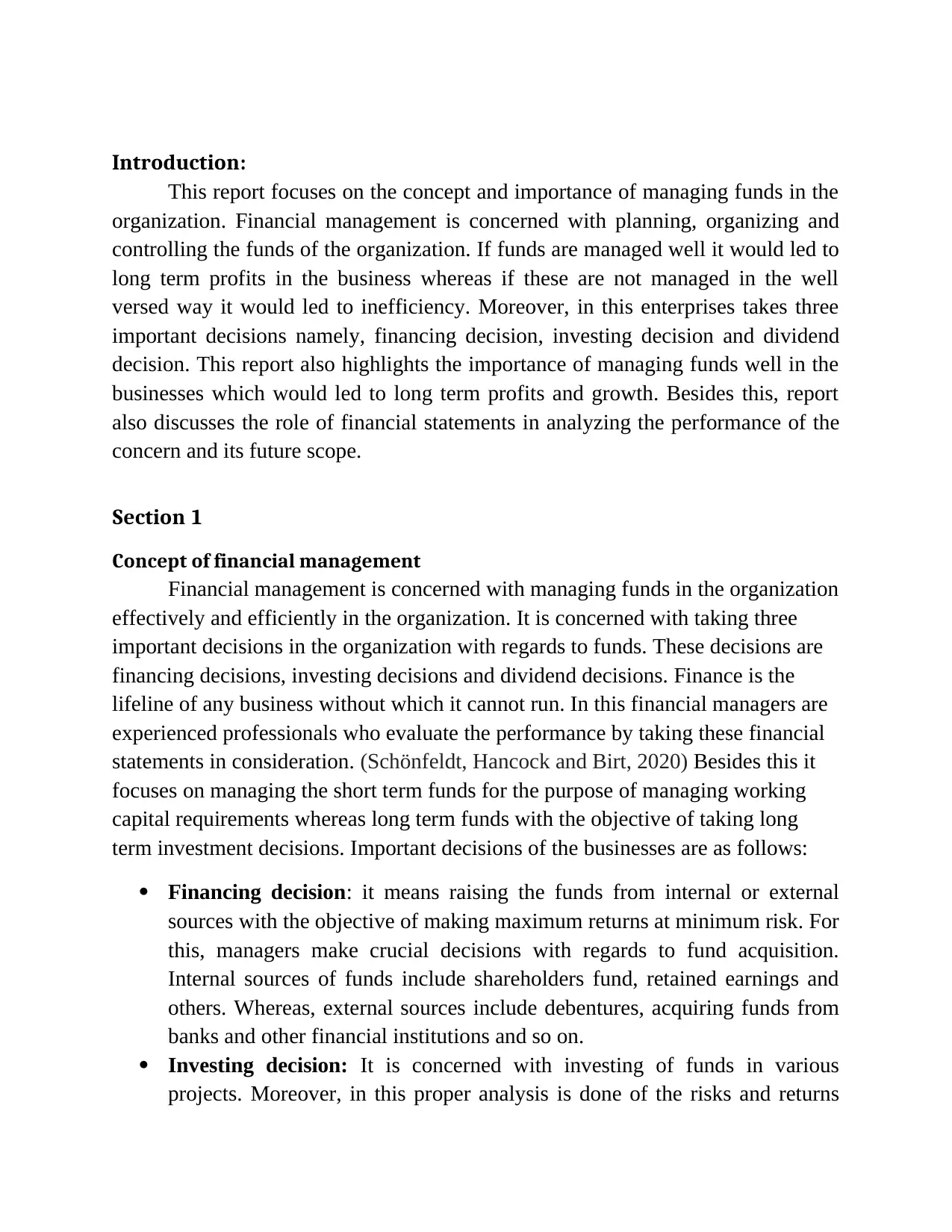
Introduction:
This report focuses on the concept and importance of managing funds in the
organization. Financial management is concerned with planning, organizing and
controlling the funds of the organization. If funds are managed well it would led to
long term profits in the business whereas if these are not managed in the well
versed way it would led to inefficiency. Moreover, in this enterprises takes three
important decisions namely, financing decision, investing decision and dividend
decision. This report also highlights the importance of managing funds well in the
businesses which would led to long term profits and growth. Besides this, report
also discusses the role of financial statements in analyzing the performance of the
concern and its future scope.
Section 1
Concept of financial management
Financial management is concerned with managing funds in the organization
effectively and efficiently in the organization. It is concerned with taking three
important decisions in the organization with regards to funds. These decisions are
financing decisions, investing decisions and dividend decisions. Finance is the
lifeline of any business without which it cannot run. In this financial managers are
experienced professionals who evaluate the performance by taking these financial
statements in consideration. (Schönfeldt, Hancock and Birt, 2020) Besides this it
focuses on managing the short term funds for the purpose of managing working
capital requirements whereas long term funds with the objective of taking long
term investment decisions. Important decisions of the businesses are as follows:
Financing decision: it means raising the funds from internal or external
sources with the objective of making maximum returns at minimum risk. For
this, managers make crucial decisions with regards to fund acquisition.
Internal sources of funds include shareholders fund, retained earnings and
others. Whereas, external sources include debentures, acquiring funds from
banks and other financial institutions and so on.
Investing decision: It is concerned with investing of funds in various
projects. Moreover, in this proper analysis is done of the risks and returns
This report focuses on the concept and importance of managing funds in the
organization. Financial management is concerned with planning, organizing and
controlling the funds of the organization. If funds are managed well it would led to
long term profits in the business whereas if these are not managed in the well
versed way it would led to inefficiency. Moreover, in this enterprises takes three
important decisions namely, financing decision, investing decision and dividend
decision. This report also highlights the importance of managing funds well in the
businesses which would led to long term profits and growth. Besides this, report
also discusses the role of financial statements in analyzing the performance of the
concern and its future scope.
Section 1
Concept of financial management
Financial management is concerned with managing funds in the organization
effectively and efficiently in the organization. It is concerned with taking three
important decisions in the organization with regards to funds. These decisions are
financing decisions, investing decisions and dividend decisions. Finance is the
lifeline of any business without which it cannot run. In this financial managers are
experienced professionals who evaluate the performance by taking these financial
statements in consideration. (Schönfeldt, Hancock and Birt, 2020) Besides this it
focuses on managing the short term funds for the purpose of managing working
capital requirements whereas long term funds with the objective of taking long
term investment decisions. Important decisions of the businesses are as follows:
Financing decision: it means raising the funds from internal or external
sources with the objective of making maximum returns at minimum risk. For
this, managers make crucial decisions with regards to fund acquisition.
Internal sources of funds include shareholders fund, retained earnings and
others. Whereas, external sources include debentures, acquiring funds from
banks and other financial institutions and so on.
Investing decision: It is concerned with investing of funds in various
projects. Moreover, in this proper analysis is done of the risks and returns
⊘ This is a preview!⊘
Do you want full access?
Subscribe today to unlock all pages.

Trusted by 1+ million students worldwide
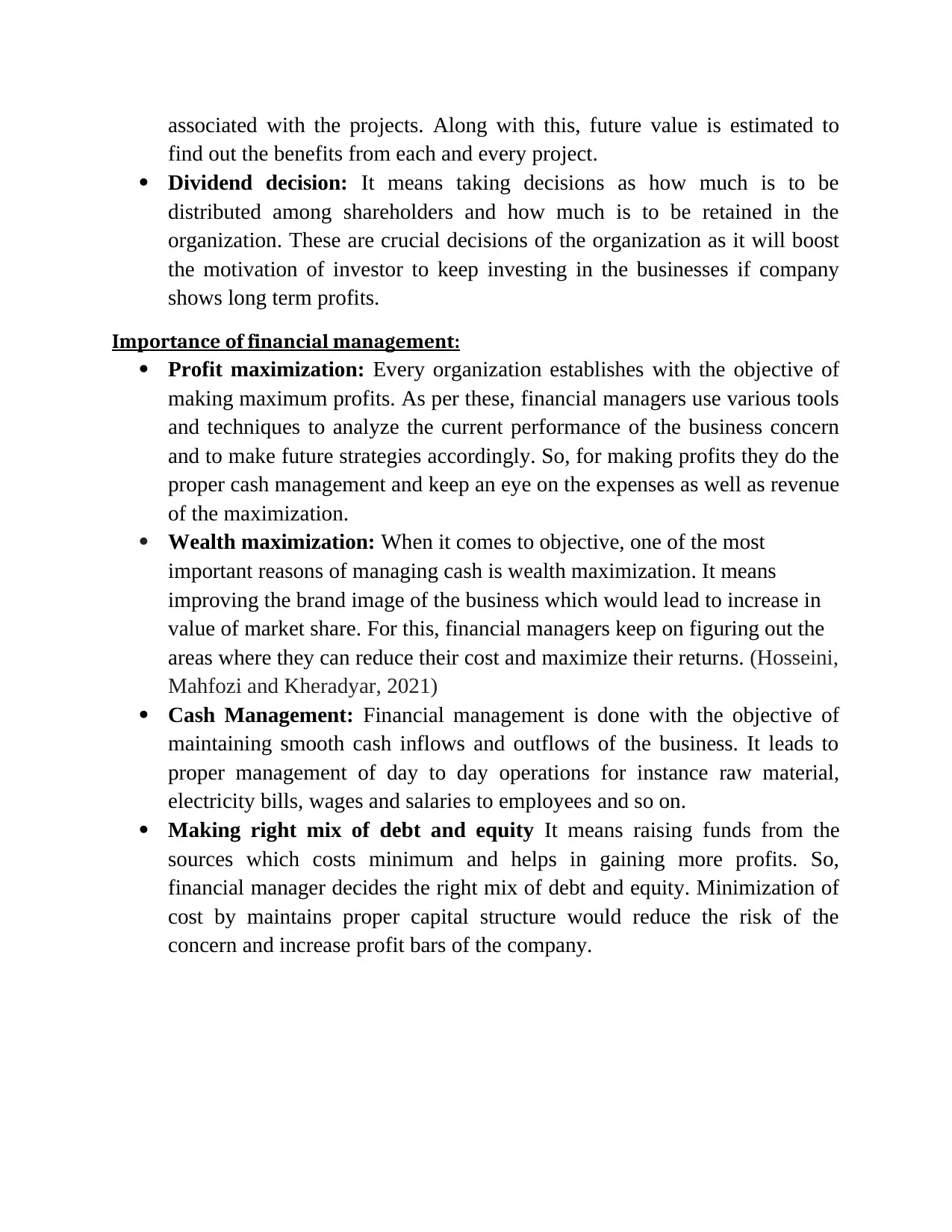
associated with the projects. Along with this, future value is estimated to
find out the benefits from each and every project.
Dividend decision: It means taking decisions as how much is to be
distributed among shareholders and how much is to be retained in the
organization. These are crucial decisions of the organization as it will boost
the motivation of investor to keep investing in the businesses if company
shows long term profits.
Importance of financial management:
Profit maximization: Every organization establishes with the objective of
making maximum profits. As per these, financial managers use various tools
and techniques to analyze the current performance of the business concern
and to make future strategies accordingly. So, for making profits they do the
proper cash management and keep an eye on the expenses as well as revenue
of the maximization.
Wealth maximization: When it comes to objective, one of the most
important reasons of managing cash is wealth maximization. It means
improving the brand image of the business which would lead to increase in
value of market share. For this, financial managers keep on figuring out the
areas where they can reduce their cost and maximize their returns. (Hosseini,
Mahfozi and Kheradyar, 2021)
Cash Management: Financial management is done with the objective of
maintaining smooth cash inflows and outflows of the business. It leads to
proper management of day to day operations for instance raw material,
electricity bills, wages and salaries to employees and so on.
Making right mix of debt and equity It means raising funds from the
sources which costs minimum and helps in gaining more profits. So,
financial manager decides the right mix of debt and equity. Minimization of
cost by maintains proper capital structure would reduce the risk of the
concern and increase profit bars of the company.
find out the benefits from each and every project.
Dividend decision: It means taking decisions as how much is to be
distributed among shareholders and how much is to be retained in the
organization. These are crucial decisions of the organization as it will boost
the motivation of investor to keep investing in the businesses if company
shows long term profits.
Importance of financial management:
Profit maximization: Every organization establishes with the objective of
making maximum profits. As per these, financial managers use various tools
and techniques to analyze the current performance of the business concern
and to make future strategies accordingly. So, for making profits they do the
proper cash management and keep an eye on the expenses as well as revenue
of the maximization.
Wealth maximization: When it comes to objective, one of the most
important reasons of managing cash is wealth maximization. It means
improving the brand image of the business which would lead to increase in
value of market share. For this, financial managers keep on figuring out the
areas where they can reduce their cost and maximize their returns. (Hosseini,
Mahfozi and Kheradyar, 2021)
Cash Management: Financial management is done with the objective of
maintaining smooth cash inflows and outflows of the business. It leads to
proper management of day to day operations for instance raw material,
electricity bills, wages and salaries to employees and so on.
Making right mix of debt and equity It means raising funds from the
sources which costs minimum and helps in gaining more profits. So,
financial manager decides the right mix of debt and equity. Minimization of
cost by maintains proper capital structure would reduce the risk of the
concern and increase profit bars of the company.
Paraphrase This Document
Need a fresh take? Get an instant paraphrase of this document with our AI Paraphraser
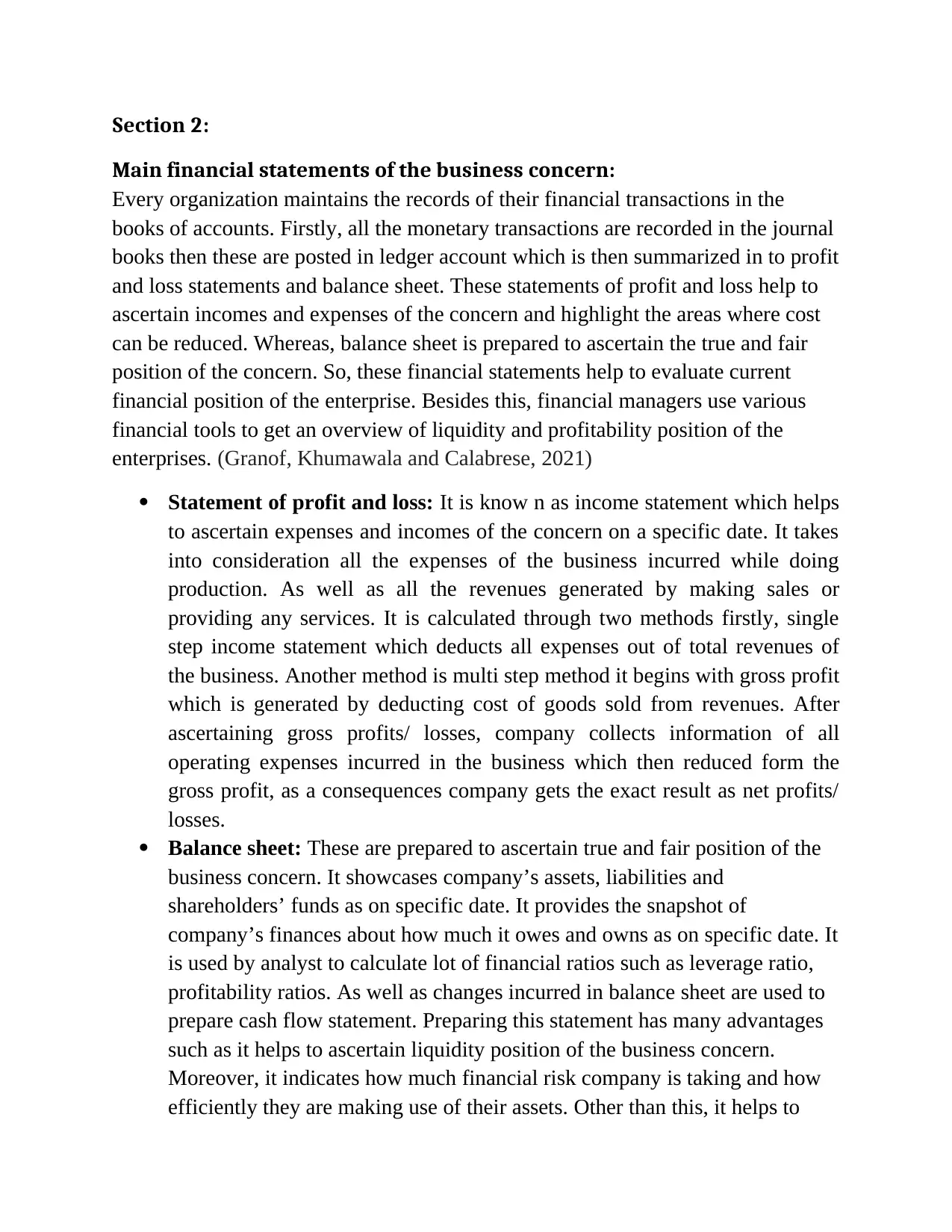
Section 2:
Main financial statements of the business concern:
Every organization maintains the records of their financial transactions in the
books of accounts. Firstly, all the monetary transactions are recorded in the journal
books then these are posted in ledger account which is then summarized in to profit
and loss statements and balance sheet. These statements of profit and loss help to
ascertain incomes and expenses of the concern and highlight the areas where cost
can be reduced. Whereas, balance sheet is prepared to ascertain the true and fair
position of the concern. So, these financial statements help to evaluate current
financial position of the enterprise. Besides this, financial managers use various
financial tools to get an overview of liquidity and profitability position of the
enterprises. (Granof, Khumawala and Calabrese, 2021)
Statement of profit and loss: It is know n as income statement which helps
to ascertain expenses and incomes of the concern on a specific date. It takes
into consideration all the expenses of the business incurred while doing
production. As well as all the revenues generated by making sales or
providing any services. It is calculated through two methods firstly, single
step income statement which deducts all expenses out of total revenues of
the business. Another method is multi step method it begins with gross profit
which is generated by deducting cost of goods sold from revenues. After
ascertaining gross profits/ losses, company collects information of all
operating expenses incurred in the business which then reduced form the
gross profit, as a consequences company gets the exact result as net profits/
losses.
Balance sheet: These are prepared to ascertain true and fair position of the
business concern. It showcases company’s assets, liabilities and
shareholders’ funds as on specific date. It provides the snapshot of
company’s finances about how much it owes and owns as on specific date. It
is used by analyst to calculate lot of financial ratios such as leverage ratio,
profitability ratios. As well as changes incurred in balance sheet are used to
prepare cash flow statement. Preparing this statement has many advantages
such as it helps to ascertain liquidity position of the business concern.
Moreover, it indicates how much financial risk company is taking and how
efficiently they are making use of their assets. Other than this, it helps to
Main financial statements of the business concern:
Every organization maintains the records of their financial transactions in the
books of accounts. Firstly, all the monetary transactions are recorded in the journal
books then these are posted in ledger account which is then summarized in to profit
and loss statements and balance sheet. These statements of profit and loss help to
ascertain incomes and expenses of the concern and highlight the areas where cost
can be reduced. Whereas, balance sheet is prepared to ascertain the true and fair
position of the concern. So, these financial statements help to evaluate current
financial position of the enterprise. Besides this, financial managers use various
financial tools to get an overview of liquidity and profitability position of the
enterprises. (Granof, Khumawala and Calabrese, 2021)
Statement of profit and loss: It is know n as income statement which helps
to ascertain expenses and incomes of the concern on a specific date. It takes
into consideration all the expenses of the business incurred while doing
production. As well as all the revenues generated by making sales or
providing any services. It is calculated through two methods firstly, single
step income statement which deducts all expenses out of total revenues of
the business. Another method is multi step method it begins with gross profit
which is generated by deducting cost of goods sold from revenues. After
ascertaining gross profits/ losses, company collects information of all
operating expenses incurred in the business which then reduced form the
gross profit, as a consequences company gets the exact result as net profits/
losses.
Balance sheet: These are prepared to ascertain true and fair position of the
business concern. It showcases company’s assets, liabilities and
shareholders’ funds as on specific date. It provides the snapshot of
company’s finances about how much it owes and owns as on specific date. It
is used by analyst to calculate lot of financial ratios such as leverage ratio,
profitability ratios. As well as changes incurred in balance sheet are used to
prepare cash flow statement. Preparing this statement has many advantages
such as it helps to ascertain liquidity position of the business concern.
Moreover, it indicates how much financial risk company is taking and how
efficiently they are making use of their assets. Other than this, it helps to
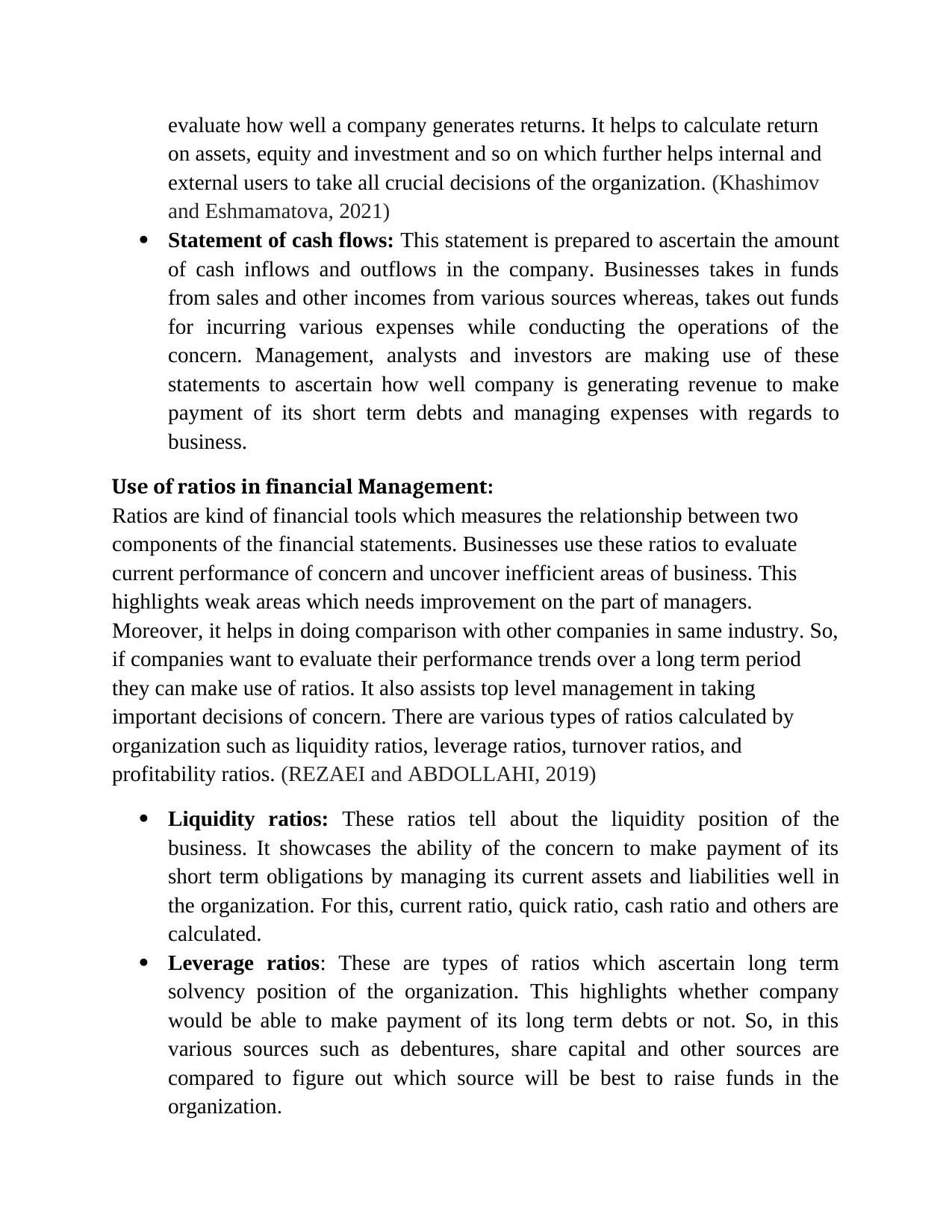
evaluate how well a company generates returns. It helps to calculate return
on assets, equity and investment and so on which further helps internal and
external users to take all crucial decisions of the organization. (Khashimov
and Eshmamatova, 2021)
Statement of cash flows: This statement is prepared to ascertain the amount
of cash inflows and outflows in the company. Businesses takes in funds
from sales and other incomes from various sources whereas, takes out funds
for incurring various expenses while conducting the operations of the
concern. Management, analysts and investors are making use of these
statements to ascertain how well company is generating revenue to make
payment of its short term debts and managing expenses with regards to
business.
Use of ratios in financial Management:
Ratios are kind of financial tools which measures the relationship between two
components of the financial statements. Businesses use these ratios to evaluate
current performance of concern and uncover inefficient areas of business. This
highlights weak areas which needs improvement on the part of managers.
Moreover, it helps in doing comparison with other companies in same industry. So,
if companies want to evaluate their performance trends over a long term period
they can make use of ratios. It also assists top level management in taking
important decisions of concern. There are various types of ratios calculated by
organization such as liquidity ratios, leverage ratios, turnover ratios, and
profitability ratios. (REZAEI and ABDOLLAHI, 2019)
Liquidity ratios: These ratios tell about the liquidity position of the
business. It showcases the ability of the concern to make payment of its
short term obligations by managing its current assets and liabilities well in
the organization. For this, current ratio, quick ratio, cash ratio and others are
calculated.
Leverage ratios: These are types of ratios which ascertain long term
solvency position of the organization. This highlights whether company
would be able to make payment of its long term debts or not. So, in this
various sources such as debentures, share capital and other sources are
compared to figure out which source will be best to raise funds in the
organization.
on assets, equity and investment and so on which further helps internal and
external users to take all crucial decisions of the organization. (Khashimov
and Eshmamatova, 2021)
Statement of cash flows: This statement is prepared to ascertain the amount
of cash inflows and outflows in the company. Businesses takes in funds
from sales and other incomes from various sources whereas, takes out funds
for incurring various expenses while conducting the operations of the
concern. Management, analysts and investors are making use of these
statements to ascertain how well company is generating revenue to make
payment of its short term debts and managing expenses with regards to
business.
Use of ratios in financial Management:
Ratios are kind of financial tools which measures the relationship between two
components of the financial statements. Businesses use these ratios to evaluate
current performance of concern and uncover inefficient areas of business. This
highlights weak areas which needs improvement on the part of managers.
Moreover, it helps in doing comparison with other companies in same industry. So,
if companies want to evaluate their performance trends over a long term period
they can make use of ratios. It also assists top level management in taking
important decisions of concern. There are various types of ratios calculated by
organization such as liquidity ratios, leverage ratios, turnover ratios, and
profitability ratios. (REZAEI and ABDOLLAHI, 2019)
Liquidity ratios: These ratios tell about the liquidity position of the
business. It showcases the ability of the concern to make payment of its
short term obligations by managing its current assets and liabilities well in
the organization. For this, current ratio, quick ratio, cash ratio and others are
calculated.
Leverage ratios: These are types of ratios which ascertain long term
solvency position of the organization. This highlights whether company
would be able to make payment of its long term debts or not. So, in this
various sources such as debentures, share capital and other sources are
compared to figure out which source will be best to raise funds in the
organization.
⊘ This is a preview!⊘
Do you want full access?
Subscribe today to unlock all pages.

Trusted by 1+ million students worldwide
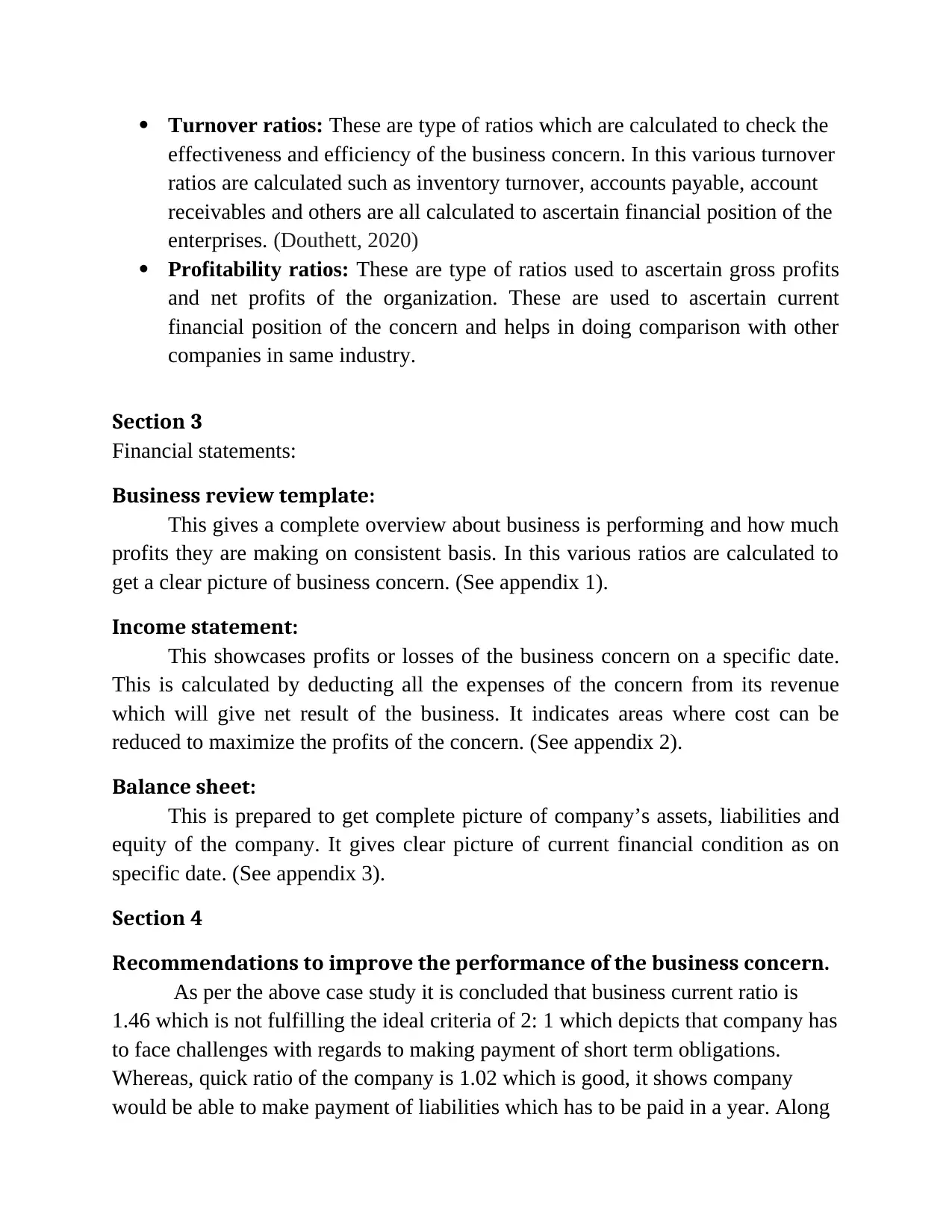
Turnover ratios: These are type of ratios which are calculated to check the
effectiveness and efficiency of the business concern. In this various turnover
ratios are calculated such as inventory turnover, accounts payable, account
receivables and others are all calculated to ascertain financial position of the
enterprises. (Douthett, 2020)
Profitability ratios: These are type of ratios used to ascertain gross profits
and net profits of the organization. These are used to ascertain current
financial position of the concern and helps in doing comparison with other
companies in same industry.
Section 3
Financial statements:
Business review template:
This gives a complete overview about business is performing and how much
profits they are making on consistent basis. In this various ratios are calculated to
get a clear picture of business concern. (See appendix 1).
Income statement:
This showcases profits or losses of the business concern on a specific date.
This is calculated by deducting all the expenses of the concern from its revenue
which will give net result of the business. It indicates areas where cost can be
reduced to maximize the profits of the concern. (See appendix 2).
Balance sheet:
This is prepared to get complete picture of company’s assets, liabilities and
equity of the company. It gives clear picture of current financial condition as on
specific date. (See appendix 3).
Section 4
Recommendations to improve the performance of the business concern.
As per the above case study it is concluded that business current ratio is
1.46 which is not fulfilling the ideal criteria of 2: 1 which depicts that company has
to face challenges with regards to making payment of short term obligations.
Whereas, quick ratio of the company is 1.02 which is good, it shows company
would be able to make payment of liabilities which has to be paid in a year. Along
effectiveness and efficiency of the business concern. In this various turnover
ratios are calculated such as inventory turnover, accounts payable, account
receivables and others are all calculated to ascertain financial position of the
enterprises. (Douthett, 2020)
Profitability ratios: These are type of ratios used to ascertain gross profits
and net profits of the organization. These are used to ascertain current
financial position of the concern and helps in doing comparison with other
companies in same industry.
Section 3
Financial statements:
Business review template:
This gives a complete overview about business is performing and how much
profits they are making on consistent basis. In this various ratios are calculated to
get a clear picture of business concern. (See appendix 1).
Income statement:
This showcases profits or losses of the business concern on a specific date.
This is calculated by deducting all the expenses of the concern from its revenue
which will give net result of the business. It indicates areas where cost can be
reduced to maximize the profits of the concern. (See appendix 2).
Balance sheet:
This is prepared to get complete picture of company’s assets, liabilities and
equity of the company. It gives clear picture of current financial condition as on
specific date. (See appendix 3).
Section 4
Recommendations to improve the performance of the business concern.
As per the above case study it is concluded that business current ratio is
1.46 which is not fulfilling the ideal criteria of 2: 1 which depicts that company has
to face challenges with regards to making payment of short term obligations.
Whereas, quick ratio of the company is 1.02 which is good, it shows company
would be able to make payment of liabilities which has to be paid in a year. Along
Paraphrase This Document
Need a fresh take? Get an instant paraphrase of this document with our AI Paraphraser
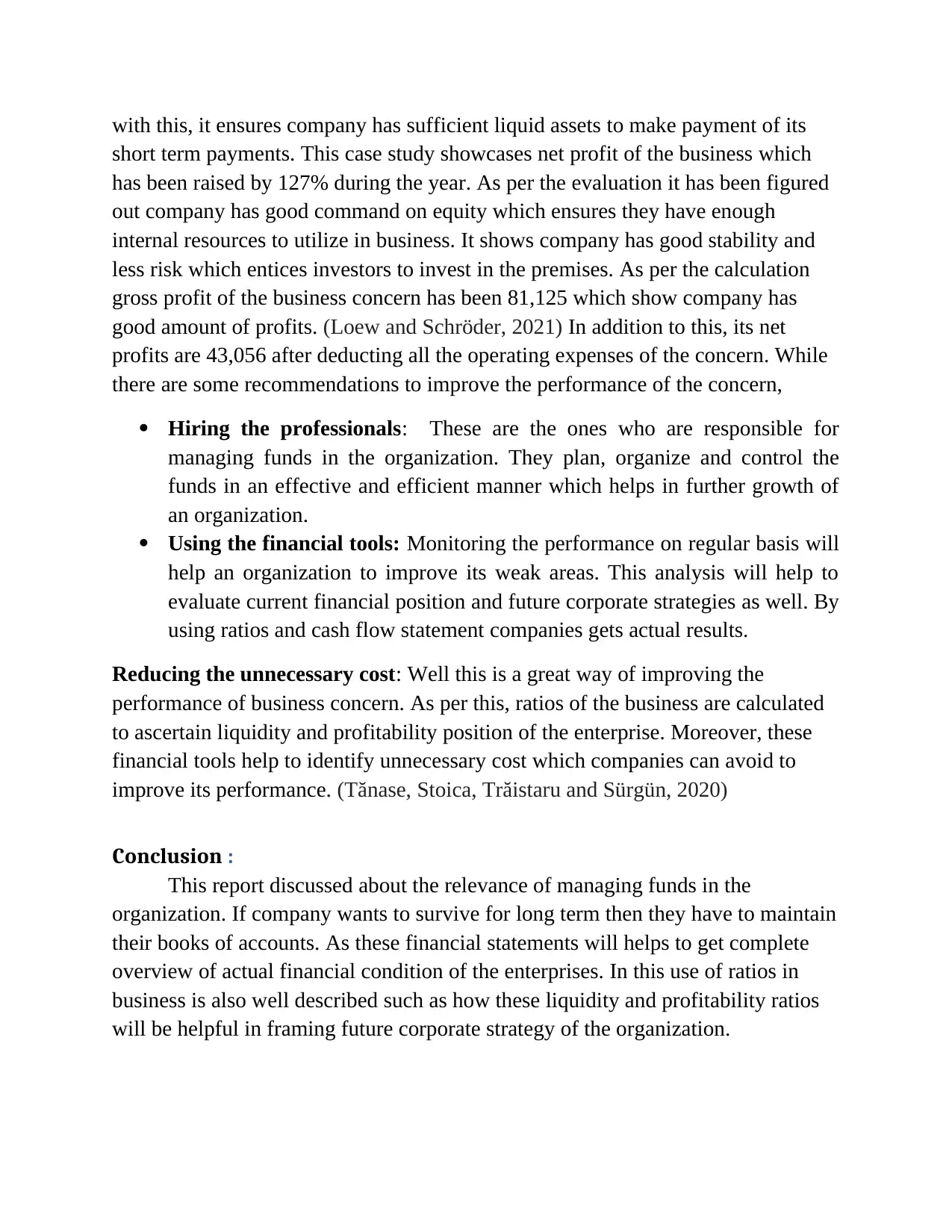
with this, it ensures company has sufficient liquid assets to make payment of its
short term payments. This case study showcases net profit of the business which
has been raised by 127% during the year. As per the evaluation it has been figured
out company has good command on equity which ensures they have enough
internal resources to utilize in business. It shows company has good stability and
less risk which entices investors to invest in the premises. As per the calculation
gross profit of the business concern has been 81,125 which show company has
good amount of profits. (Loew and Schröder, 2021) In addition to this, its net
profits are 43,056 after deducting all the operating expenses of the concern. While
there are some recommendations to improve the performance of the concern,
Hiring the professionals: These are the ones who are responsible for
managing funds in the organization. They plan, organize and control the
funds in an effective and efficient manner which helps in further growth of
an organization.
Using the financial tools: Monitoring the performance on regular basis will
help an organization to improve its weak areas. This analysis will help to
evaluate current financial position and future corporate strategies as well. By
using ratios and cash flow statement companies gets actual results.
Reducing the unnecessary cost: Well this is a great way of improving the
performance of business concern. As per this, ratios of the business are calculated
to ascertain liquidity and profitability position of the enterprise. Moreover, these
financial tools help to identify unnecessary cost which companies can avoid to
improve its performance. (Tănase, Stoica, Trăistaru and Sürgün, 2020)
Conclusion :
This report discussed about the relevance of managing funds in the
organization. If company wants to survive for long term then they have to maintain
their books of accounts. As these financial statements will helps to get complete
overview of actual financial condition of the enterprises. In this use of ratios in
business is also well described such as how these liquidity and profitability ratios
will be helpful in framing future corporate strategy of the organization.
short term payments. This case study showcases net profit of the business which
has been raised by 127% during the year. As per the evaluation it has been figured
out company has good command on equity which ensures they have enough
internal resources to utilize in business. It shows company has good stability and
less risk which entices investors to invest in the premises. As per the calculation
gross profit of the business concern has been 81,125 which show company has
good amount of profits. (Loew and Schröder, 2021) In addition to this, its net
profits are 43,056 after deducting all the operating expenses of the concern. While
there are some recommendations to improve the performance of the concern,
Hiring the professionals: These are the ones who are responsible for
managing funds in the organization. They plan, organize and control the
funds in an effective and efficient manner which helps in further growth of
an organization.
Using the financial tools: Monitoring the performance on regular basis will
help an organization to improve its weak areas. This analysis will help to
evaluate current financial position and future corporate strategies as well. By
using ratios and cash flow statement companies gets actual results.
Reducing the unnecessary cost: Well this is a great way of improving the
performance of business concern. As per this, ratios of the business are calculated
to ascertain liquidity and profitability position of the enterprise. Moreover, these
financial tools help to identify unnecessary cost which companies can avoid to
improve its performance. (Tănase, Stoica, Trăistaru and Sürgün, 2020)
Conclusion :
This report discussed about the relevance of managing funds in the
organization. If company wants to survive for long term then they have to maintain
their books of accounts. As these financial statements will helps to get complete
overview of actual financial condition of the enterprises. In this use of ratios in
business is also well described such as how these liquidity and profitability ratios
will be helpful in framing future corporate strategy of the organization.
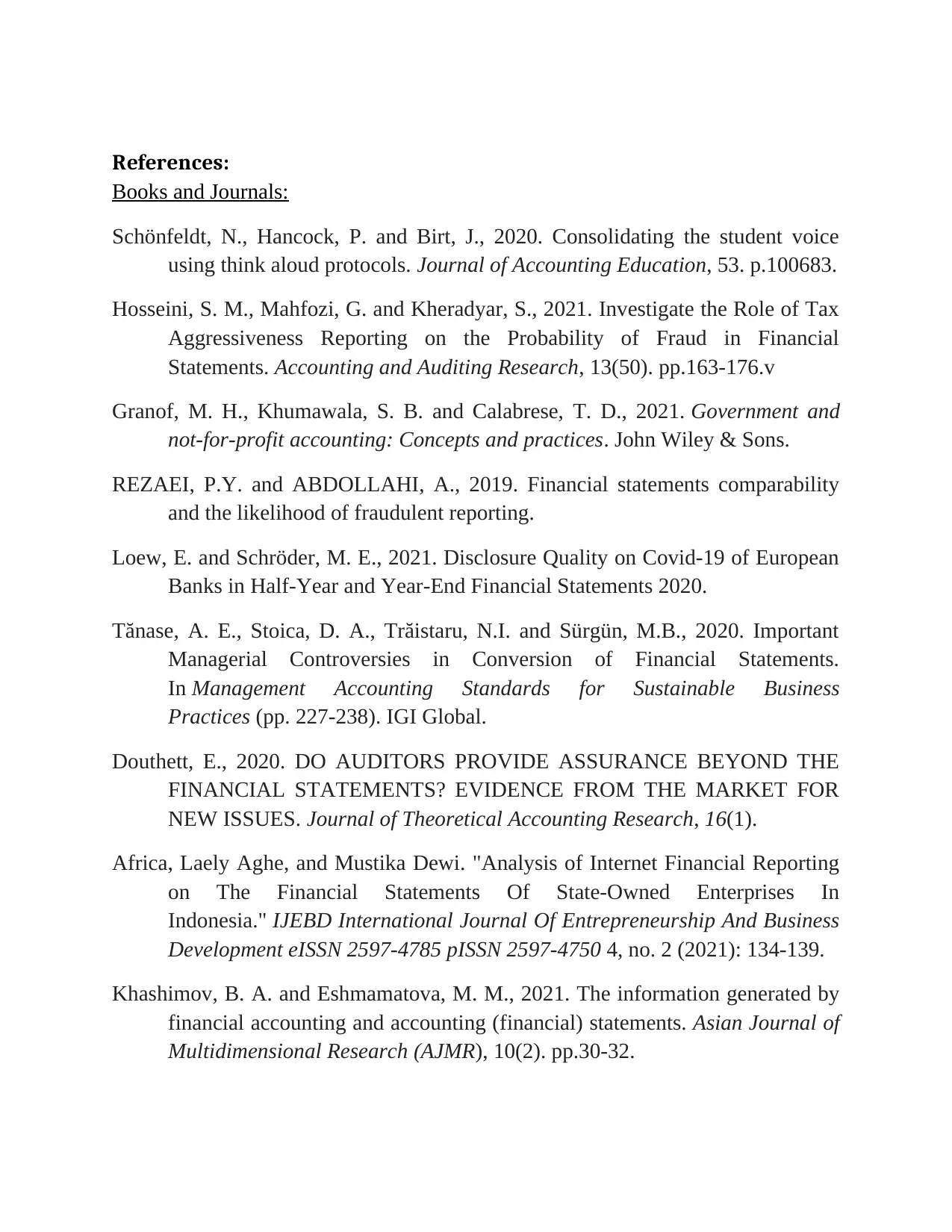
References:
Books and Journals:
Schönfeldt, N., Hancock, P. and Birt, J., 2020. Consolidating the student voice
using think aloud protocols. Journal of Accounting Education, 53. p.100683.
Hosseini, S. M., Mahfozi, G. and Kheradyar, S., 2021. Investigate the Role of Tax
Aggressiveness Reporting on the Probability of Fraud in Financial
Statements. Accounting and Auditing Research, 13(50). pp.163-176.v
Granof, M. H., Khumawala, S. B. and Calabrese, T. D., 2021. Government and
not-for-profit accounting: Concepts and practices. John Wiley & Sons.
REZAEI, P.Y. and ABDOLLAHI, A., 2019. Financial statements comparability
and the likelihood of fraudulent reporting.
Loew, E. and Schröder, M. E., 2021. Disclosure Quality on Covid-19 of European
Banks in Half-Year and Year-End Financial Statements 2020.
Tănase, A. E., Stoica, D. A., Trăistaru, N.I. and Sürgün, M.B., 2020. Important
Managerial Controversies in Conversion of Financial Statements.
In Management Accounting Standards for Sustainable Business
Practices (pp. 227-238). IGI Global.
Douthett, E., 2020. DO AUDITORS PROVIDE ASSURANCE BEYOND THE
FINANCIAL STATEMENTS? EVIDENCE FROM THE MARKET FOR
NEW ISSUES. Journal of Theoretical Accounting Research, 16(1).
Africa, Laely Aghe, and Mustika Dewi. "Analysis of Internet Financial Reporting
on The Financial Statements Of State-Owned Enterprises In
Indonesia." IJEBD International Journal Of Entrepreneurship And Business
Development eISSN 2597-4785 pISSN 2597-4750 4, no. 2 (2021): 134-139.
Khashimov, B. A. and Eshmamatova, M. M., 2021. The information generated by
financial accounting and accounting (financial) statements. Asian Journal of
Multidimensional Research (AJMR), 10(2). pp.30-32.
Books and Journals:
Schönfeldt, N., Hancock, P. and Birt, J., 2020. Consolidating the student voice
using think aloud protocols. Journal of Accounting Education, 53. p.100683.
Hosseini, S. M., Mahfozi, G. and Kheradyar, S., 2021. Investigate the Role of Tax
Aggressiveness Reporting on the Probability of Fraud in Financial
Statements. Accounting and Auditing Research, 13(50). pp.163-176.v
Granof, M. H., Khumawala, S. B. and Calabrese, T. D., 2021. Government and
not-for-profit accounting: Concepts and practices. John Wiley & Sons.
REZAEI, P.Y. and ABDOLLAHI, A., 2019. Financial statements comparability
and the likelihood of fraudulent reporting.
Loew, E. and Schröder, M. E., 2021. Disclosure Quality on Covid-19 of European
Banks in Half-Year and Year-End Financial Statements 2020.
Tănase, A. E., Stoica, D. A., Trăistaru, N.I. and Sürgün, M.B., 2020. Important
Managerial Controversies in Conversion of Financial Statements.
In Management Accounting Standards for Sustainable Business
Practices (pp. 227-238). IGI Global.
Douthett, E., 2020. DO AUDITORS PROVIDE ASSURANCE BEYOND THE
FINANCIAL STATEMENTS? EVIDENCE FROM THE MARKET FOR
NEW ISSUES. Journal of Theoretical Accounting Research, 16(1).
Africa, Laely Aghe, and Mustika Dewi. "Analysis of Internet Financial Reporting
on The Financial Statements Of State-Owned Enterprises In
Indonesia." IJEBD International Journal Of Entrepreneurship And Business
Development eISSN 2597-4785 pISSN 2597-4750 4, no. 2 (2021): 134-139.
Khashimov, B. A. and Eshmamatova, M. M., 2021. The information generated by
financial accounting and accounting (financial) statements. Asian Journal of
Multidimensional Research (AJMR), 10(2). pp.30-32.
⊘ This is a preview!⊘
Do you want full access?
Subscribe today to unlock all pages.

Trusted by 1+ million students worldwide
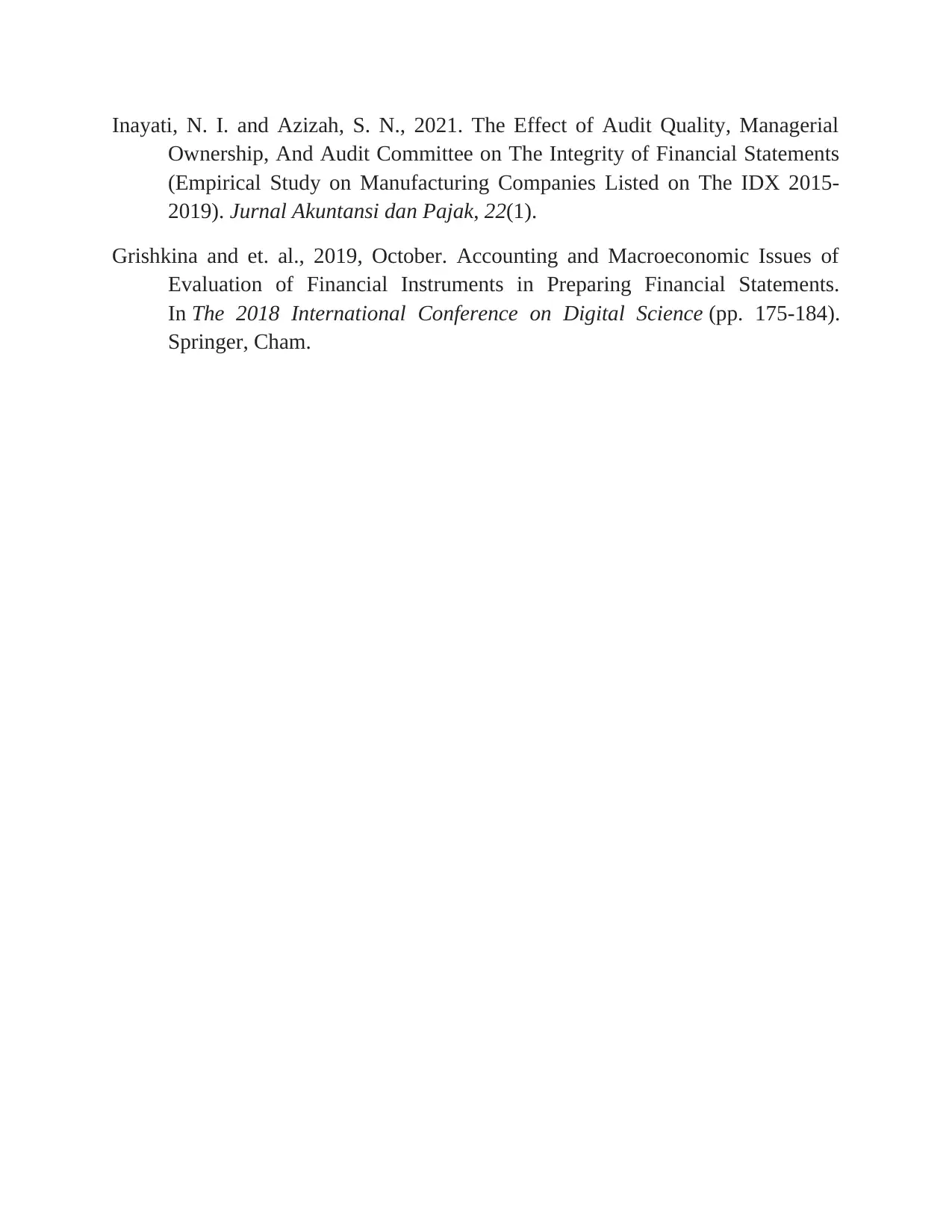
Inayati, N. I. and Azizah, S. N., 2021. The Effect of Audit Quality, Managerial
Ownership, And Audit Committee on The Integrity of Financial Statements
(Empirical Study on Manufacturing Companies Listed on The IDX 2015-
2019). Jurnal Akuntansi dan Pajak, 22(1).
Grishkina and et. al., 2019, October. Accounting and Macroeconomic Issues of
Evaluation of Financial Instruments in Preparing Financial Statements.
In The 2018 International Conference on Digital Science (pp. 175-184).
Springer, Cham.
Ownership, And Audit Committee on The Integrity of Financial Statements
(Empirical Study on Manufacturing Companies Listed on The IDX 2015-
2019). Jurnal Akuntansi dan Pajak, 22(1).
Grishkina and et. al., 2019, October. Accounting and Macroeconomic Issues of
Evaluation of Financial Instruments in Preparing Financial Statements.
In The 2018 International Conference on Digital Science (pp. 175-184).
Springer, Cham.
Paraphrase This Document
Need a fresh take? Get an instant paraphrase of this document with our AI Paraphraser
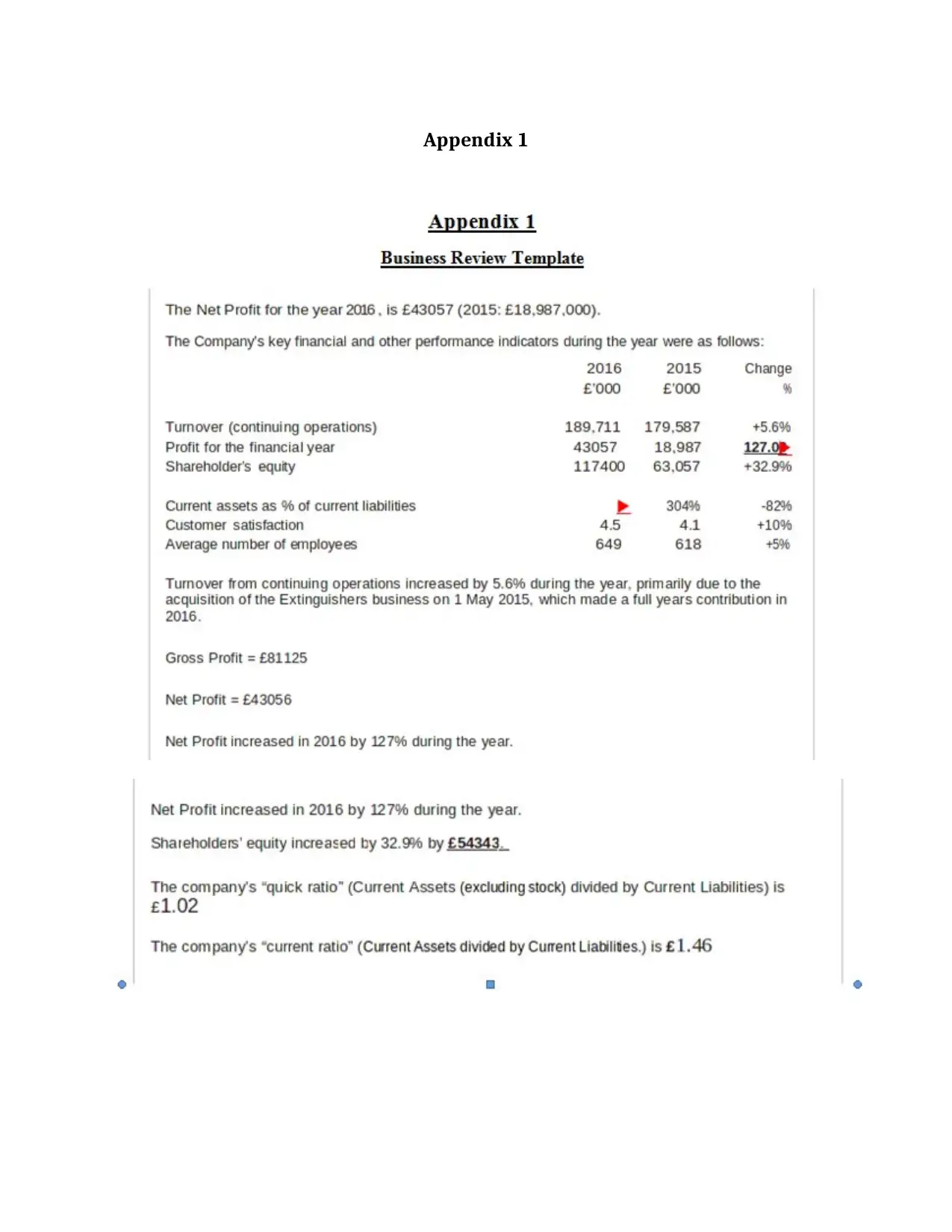
Appendix 1
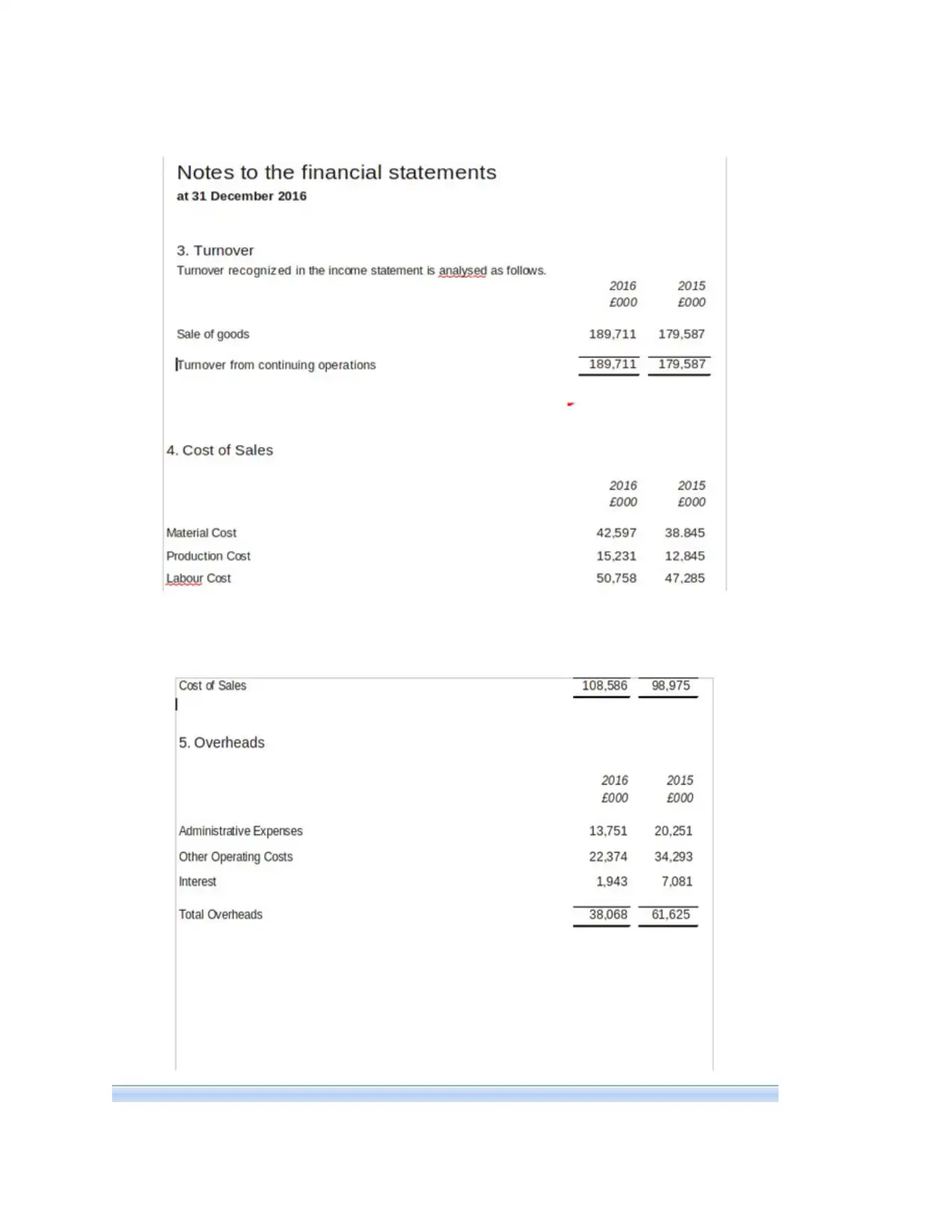
⊘ This is a preview!⊘
Do you want full access?
Subscribe today to unlock all pages.

Trusted by 1+ million students worldwide
1 out of 16
Related Documents
Your All-in-One AI-Powered Toolkit for Academic Success.
+13062052269
info@desklib.com
Available 24*7 on WhatsApp / Email
![[object Object]](/_next/static/media/star-bottom.7253800d.svg)
Unlock your academic potential
Copyright © 2020–2025 A2Z Services. All Rights Reserved. Developed and managed by ZUCOL.


